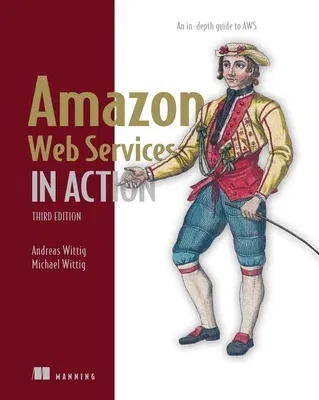Andreas Wittig
(Author)Amazon Web Services in Action, Third Edition: An In-Depth Guide to AwsPaperback, 2 May 2023


Description
Master essential best practices for deploying and managing applications on Amazon Web Services. This revised bestseller is packed with techniques for building highly available and scalable architectures and automating deployment with Infrastructure as Code.
-
Leverage globally distributed data centers to launch virtual machines with EC2
-
Store and archive large volumes of data with EBS, S3, and EFS
-
Persist and query data with highly available and scalable database systems with RDS and DynamoDB
-
Enhance performance with caching data in-memory with ElastiCache and MemoryDB
-
Use Infrastructure as Code to automate your cloud infrastructure
-
Secure workloads running in the cloud with VPC and IAM
-
Build fault-tolerant web applications with ALB and SQS
-
Automate common sysadmin tasks with Lambda, CLI, and SDK
-
Build cloud-native applications based on containers with AppRunner, ECS, Fargate
Thousands of developers have chosen Amazon Web Services in Action: An in-depth guide to AWS to help them succeed with the AWS cloud. Readers love this all-practical handbook for its complete introduction to computing, storage, and networking, along with best practices for all core AWS services. This revised third edition features new chapters on containerization, along with a variety of AWS innovations. You'll also learn how automating your infrastructure with IAC is a game changer for your cloud deployment, delivering a massive boost to efficiency and quality.
Purchase of the print book includes a free eBook in PDF, Kindle, and ePub formats from Manning Publications.
About the Technology
Amazon Web Services, the leading cloud computing platform, offers customers APIs for on-demand access to computing services. Rich in examples and best practices of how to use AWS, this Manning bestseller is now released in its third, revised, and improved edition.
About the Book
In Amazon Web Services in Action, Third Edition: An in-depth guide to AWS, the Wittig brothers give you a comprehensive, practical introduction to deploying and managing applications on the AWS cloud platform. With a sharp focus on the most important AWS tasks and services, they will save you hours of unproductive time. You'll learn hands-on as you complete real-world projects like hosting a WordPress site, setting up a private cloud, and deploying an app on containers.
What's Inside
-
Leverage globally distributed data centers to launch virtual machines
-
Enhance performance with caching data in-memory
-
Secure workloads running in the cloud with VPC and IAM
-
Build fault-tolerant web applications with ALB and SQS
About the Reader
Written for mid-level developers, DevOps or platform engineers, architects, and system administrators.
About the Author
Andreas Wittig and Michael Wittig are software engineers and consultants focused on AWS. Together, they migrated the first bank in Germany to AWS in 2013.
Table of Contents
PART 1 - GETTING STARTED
1 What is Amazon Web Services?
2 A simple example: WordPress in 15 minutes
PART 2 - BUILDING VIRTUAL INFRASTRUCTURE CONSISTING OF COMPUTERS AND
NETWORKING
3 Using virtual machines: EC2
4 Programming your infrastructure: The command line, SDKs, and
CloudFormation
5 Securing your system: IAM, security groups, and VPC
6 Automating operational tasks with Lambda
PART 3 - STORING DATA IN THE CLOUD
7 Storing your objects: S3
8 Storing data on hard drives: EBS and instance store
9 Sharing data volumes between machines: EFS
10 Using a relational database service: RDS
11 Caching data in memory: Amazon ElastiCache and MemoryDB
12 Programming for the NoSQL database service: DynamoDB
PART 4 - ARCHITECTING ON AWS
13 Achieving high availability: Availability zones, autoscaling, and
CloudWatch
14 Decoupling your infrastructure: Elastic Load Balancing and Simple
Queue
Service
15 Automating deployment: CodeDeploy, CloudFormation, and Packer
16 Designing for fault tolerance
17 Scaling up and down: Autoscaling and CloudWatch
18 Building modern architectures for the cloud: ECS, Fargate, and App
Runner